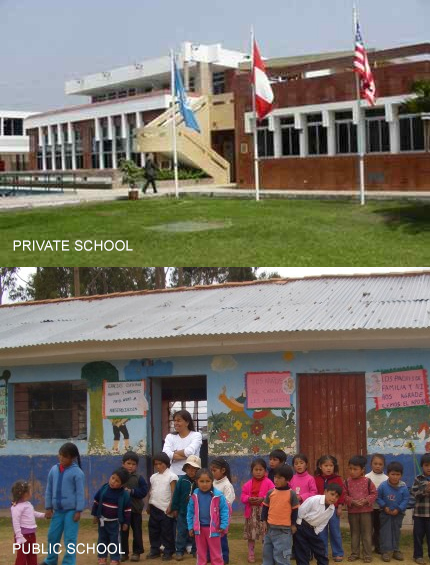
Private schools “… are not operated by a public authority but controlled and managed, whether for profit or not, by a private body such as a nongovernmental organization, religious body, special interest group, foundation or business enterprise” (Trading Economics). Depending on what private school the family decides, it can cost anywhere from a couple of hundred Nuevos Soles to thousands of American dollars per month. Many families in Peru try and make sure that they send their children to private school because the education and structure is generally better.
Every year, private enrollment continues to raise at least by 8% or more. Depending on whom you are talking to, it could be considered quite a stupendous increase or, conversely, a microscopic increase.The other type of school that Peru has is public schools.
There are two main types of primary public schools- regular teaching and multigrade schools. Multigrade schools are made up of students who are not in the same grade but are placed into a classroom with each other and one teacher. These types of schools are very popular in countryside and jungle schools. Public education is supposed to be free but sometimes there are fees that come along with it. Many times the teachers are not paid properly so they are absent a lot. Protests are common, so when a protest occurs, class is cancelled until the protest is over or until the teacher decides to come back. Due to low budgeting the infrastructure is weak and materials are scarce.
Looking at a census done on public schools in 2010, only 18.3% of the public schools were considered to be in good condition. This means that 18.3% of the schools have working toilets, workbooks and materials for the students, electricity, and appropriate and qualified teachers. Peru has had a very difficult time setting standards for education with students and teachers. The Ministry of Education was the first to create standards for Peruvian education. They started to establish a so-called five-year education during the years of 1980 to 1985.
Nothing really big happened until 1993 when the minister spread a new regulation of the organization and functions of the Ministry, and is effective rationalization with leaving workers to reorganization. The office of Educational Infrastructure, which is a sub- division within the Ministry of Education coordinates the demands and needs for location, construction, equipment and maintenance of educational infrastructure (MINEDU).The office of Education Infrastructure works with the International Bank and Inter-American Development Bank when obtaining loans. Recently in 2004, a loan agreement was made called Education Program in Rural Areas.
The purpose of this loan was to raise the level of learning of children and youth in rural areas- trying to close the inequality gap between rural and urban areas. They designed intervention strategies organized into three components to improve educational quality and efficiency. These were, “increase access, improve quality, and expand the efficiency in education management” (MINEDU).
Thereafter, the Peruvian education system has undergone major changes and tremendous progress in terms of infrastructure and quality, although much still remains to be improved.
